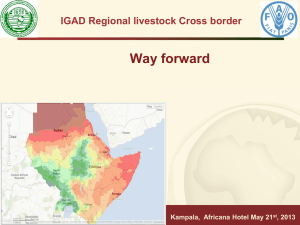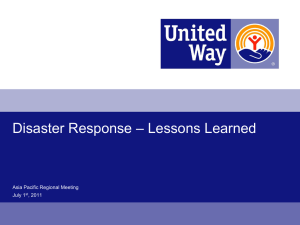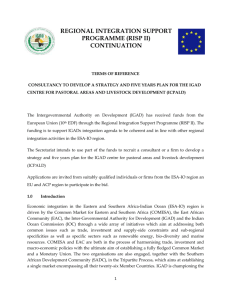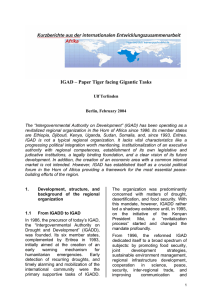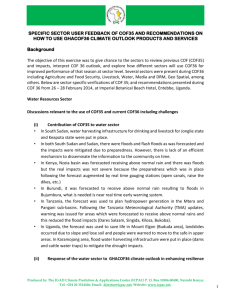Intergovernmental Authority on Development (IGAD)
advertisement
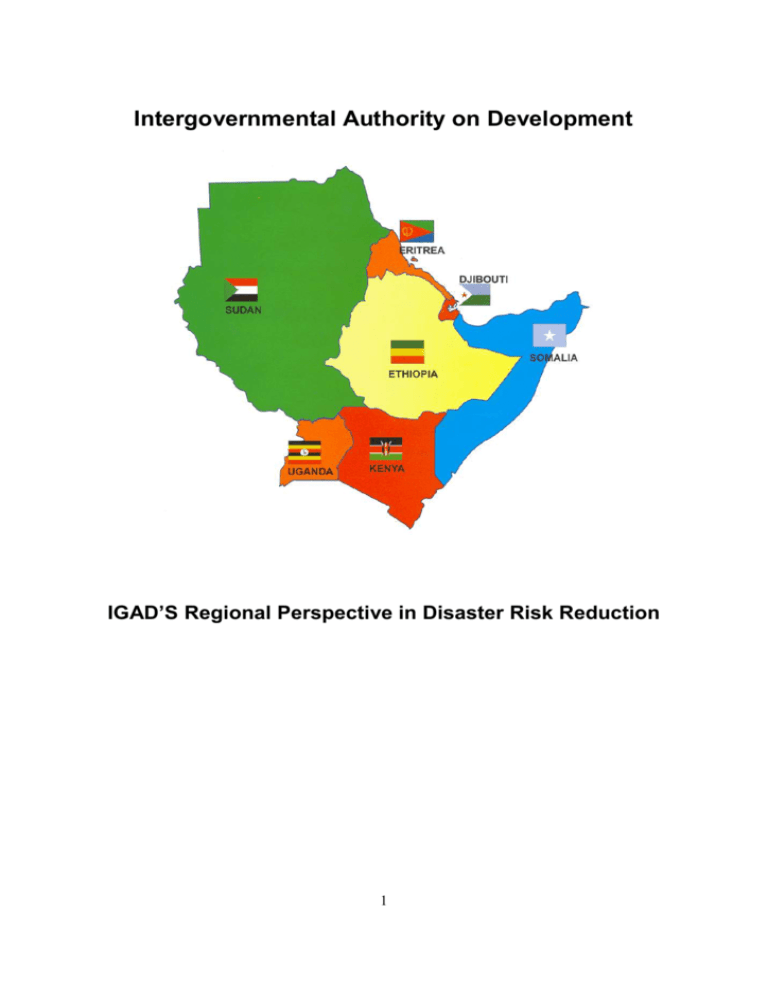
Intergovernmental Authority on Development IGAD’S Regional Perspective in Disaster Risk Reduction 1 1. INTRODUCTION The IGAD region stretches over an area of 5.2 million km2 and a population of over 170 million comprising the countries of Djibouti, Eritrea, Ethiopia, Kenya, Somalia, Sudan and Uganda. The region has great variety of climates and landscapes including mountain glaciers, tropical rain forests, and grasslands as well as arid and semiarid areas among other features. The Region is prone to recurrent hazards such as droughts and floods making it one of the most vulnerable regions on the African continent to climate variability and change. IGAD was initially established to address issues of drought and development in the Region. It was revitalised in 1996 and its mandate expanded. IGAD’s expanded mandate is to coordinate and harmonise policies in the areas of socio-economic, agricultural development, environmental protection and political and humanitarian affairs. The prioritisation of programme and projects in the expanded areas of cooperation recognizes the alleviation and mitigation of humanitarian crises as an integral part of IGAD’s overall strategy for sustainable development in the Region. Series of natural and human-made hazards that cause disasters in the IGAD Region have enabled the political leaders to realise the need for more integrated cooperation in the Region. IGAD member countries are at risk from a wide range of natural, technological and environmental hazards that can lead to disasters. Member countries have, in their limited capacities, followed separate strategies to respond to these disasters. Experiences have shown that past strategies and response mechanisms have never been adequate. In this regard there is need for a comprehensive policy on disaster risk management that is proactive and harmonises policies and activities and opens initiatives for regional collaboration. In the region, the disaster risk management sector mirrors the economic situation of most of the IGAD countries. Unless a disaster occurs, disaster risk management is given a low priority by both governments and donors. Disaster response receives resources and funds during emergency periods but long-term development of disaster risk management capabilities, prevention, mitigation and preparedness measures are not well addressed. Over 90% of disasters in IGAD sub region are climate related. It is in this regard that IGAD has established a specialized centre known as IGAD Climate and application centre (ICPAC) to help IGAD effectively cope with challenges of present climate variability such as droughts and floods as well as adapt to future climate changes. 2. HAZARDS OF THE REGION AND STATUS REPORT Drought: Most of IGAD region may be classified as arid and semi arid with high climate variability, with more than 40 percent of the IGAD population lives in semi-arid to hyper-arid zones. Drought is another major hazard in the region. The presence of large tracts of arid and semi-arid land and other factors, such as widespread reliance on subsistence farming and pastoralism, weak farming and livestock management systems, population pressures and water scarcity, all contribute to desertification, environmental degradation and deforestation. Floods: Many droughts are often followed by floods or vice versa due to close linkages of extreme climate in the region to El Nino and other recurrent climate systems. The recurrences of climate stresses and population pressures have continued to reduce the use and effectiveness of traditional coping mechanisms. 2 Climate change Recent IPCC assessments have shown that climate change is real and IGAD region is one of the most vulnerable locations in the world due to the negative impacts of future climate changes since it has low coping capacity. Climate change adaptation is therefore not an option for the region. Few efforts are currently on going in the region. Conflict: Resources based wars and civil unrest have become the most serious causes of food insecurity in the region, disrupting food production and marketing activities. Relief and recovery measures to support millions of displaced persons use resources that would otherwise be available for national development. There is need to find permanent solutions to communities being displaced by conflicts. Some of the conflicts are over limited food, water and grazing resources. Coping with current climate extremes and adaptation to future climate change is critical for sustainable peace in the region. Fire: Fire is a common hazard in urban centres, especially in slum areas. Fire hazards are also common in the rural forests during the dry periods. Rural fire control resources are scarce and under favourable conditions fires can spread rapidly, destroying property, subsistence, crops, shelter, forests and the associated flora and fauna, as well as leaving the land vulnerable to erosion. Pandemics, Epidemics and Pest infestation: The risk of large-scale epidemics in the IGAD Region is high owing to the presence of several endemic diseases, poverty, poor access to modern health services and weak systems of epidemiological surveillance. The risk for disasters has been greatly increased by the spread of the HIV/AIDS pandemic. Of the epidemics, malaria is probably the biggest threat in most IGAD countries. Livestock diseases such rift valley fever; among others are also key threats to food security and livelihoods in the region. Locusts, Army worms and invasions of many other tropical pests also often threaten livelihoods in the IGAD Region. Environmental hazards including desertification, deforestation, ecosystem degradation, and environmental pollution are common in the region. All Member States in the IGAD Region are vulnerable to environmental degradation due to climatic conditions, population pressures, and lack of policies, legislation and support for environmental protection. Earthquake: The Great Rift Valley runs through IGAD Sub region. Tectonic activity associated with the Great East African Rift System produces earthquakes in the Rift Valley and adjacent highlands. Vulnerability to earthquakes is significant due to lack of consideration of seismic risk in land use planning and poor building standards. Youth, Gender and Disaster Risk Management in IGAD: Youth and Women have gained little from the different activities undertaken in the IGAD region regarding disaster management. The limited capacity of disaster risk management personnel to undertake youth and gender analysis; and to develop targeted activities for youth and women’s empowerment has contributed to poor articulation of and incorporation of gender issues in a systematic manner in disaster management. Disaster risk Reduction Policies: Although IGAD has been given a mandate for regional disaster risk reduction policies, its responsibilities and policies in relation to this role have not been clearly defined. National policies and strategies are poorly articulated and are not well integrated. The only consolidated and comprehensive policies in the region appear to be those in Ethiopia’s National Policy on Disaster Prevention and Mitigation (NPDPM) published in 1993. Kenya and Uganda are currently developing their policies. There are some disaster risk management legislations in every country but in many countries, it is included in other legislation and is difficult to identify. National disaster risk management agencies in the 3 region have developed in isolation and are not in the mainstream of disaster risk management theory and practice. There is no focal point for effective information exchange or mechanism for such exchange in many countries, although some ISDR focal points have been established in some countries. Regional collaboration: Many hazards and associated impacts often extend beyond individual national borders that require close regional collaboration. Contacts between national disaster risk management agencies are rare despite the existence of a number of common hazards and increasing contact between regional scientific agencies. No collaborative sub-national disaster risk management activities exist, and there are no agreements on disaster risk management harmonisation in the region. 3. Early warning and information system Some Early warning initiatives are being undertaken at both the country level and the regional level, but their effectiveness is often limited in scope and duration and do not always allow undertaking disaster and risk management processes in a comprehensive and coherent way. IGAD has established specialized institutions to address some of the early warning aspects including the following: IGAD Climate Prediction and Applications Centre (ICPAC) ICPAC is a specialized institution of the Intergovernmental Authority on development (IGAD) charged with the responsibility of coordinating all regional climate risk reduction related issues in the Region. The mission of ICPAC is to provide climate information, prediction, timely early warning for applications in support of environmental management, disaster risk reduction and sustainable development in the IGAD Region. ICPAC also supports capacity building and pilot demonstration activities including integration of indigenous knowledge in climate risk reduction activities. Conflict Early Warning and Response Mechanism (CEWARN) CEWARN is an initiative of the Inter-governmental Authority on Development (IGAD), designed to serve the Region as a mechanism that systematically anticipates and responds to violent conflicts in a timely and effective manner. CEWARN’s mission is to establish itself as an effective and sustainable sub-regional mechanism that undertakes conflict Early Warning and Early Response and fosters cooperation among relevant stakeholders in order to respond to potential and actual violent conflicts in the region in a timely manner. ICPAC and CEWARN have close collaborations due to close interactions of the issues being addressed by the individual institutions. 4. DISASTER RISK MANAGEMENT PROGRAMME IGAD currently has a disaster risk management programme that seeks to recuperate, systematise, make express and conscious move to improve the strategies that the communities have developed (many times in an isolated manner) within a social, economic and environmental context in permanent change. The objective of the programme is to enhance the disaster risk management capabilities of IGAD and improve the capacity of member states to develop comprehensive disaster risk management strategies and plans through managing the risks rather than the disaster itself. Programme Strategies: Elaboration of supporting policies, legislation and agreements for disaster management; 4 Development of disaster preparedness strategies and the contingency planning process; Improvement of regional collaboration for preparedness and response; Strengthening of early warning and information systems and vulnerability analysis; Development of education and training for disaster mitigation; Improving preparedness for impact and needs assessment and resource mobilisation; and Improving preparedness for targeting, implementation and monitoring and evaluation of relief and rehabilitation assistance. 5 KEY ACCOMPLISHMENTS AND CHALLENGES IGAD with the active involvement and participation of its member states has developed a comprehensive Disaster Risk Management programme. Two important mechanisms have already been established. These mechanisms are the Ministerial Committee in charge of Disaster risk management Institutions of the member states for policy and political guidance, and Technical Advisory Panel drawn from member states to assist in technical matters during the implementation period. Regional Programme Implementation Team established primarily to assess the current policies, strategies and plans in consultation with national disaster risk management institutions, international agencies Mobilized resources to kick start implementing the Programme Developed a comprehensive Disaster Risk Management Training Kit for the member states The status of Disaster Risk Management instruments (policies, legislations, strategies and national plan of actions) are currently being reviewed in order to develop a regional framework of intervention to assist member states in achieving the objectives of Disaster Disk Management programme. Established of two key institution namely ICPAC and CEWARN The main Challenges include: No effective mainstreaming of disaster risk management in the national and sectoral development programmes of the countries. How to sustain the political commitment of the member states, and also how to practically translate the commitment in practical terms both at national and regional level. The political commitment rests in the realization by policy makers that disaster risk management is a development issue and not an emergency or humanitarian issue. Non promotion of multi-hazard and multi-sectoral approach Convincing donors/partners to provide adequate/equal recognition to disaster risk management vis-à-vis humanitarian response in managing disaster risks. Strengthening indigenous coping mechanism of the respective communities in the member states. 5

